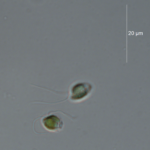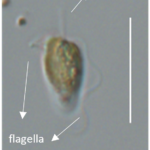Detected Species
-
HAB Species
- Diatoms
- Dinoflagellates
- Cyanobacteria
- Raphidophytes
- Haptophytes
-
Non-toxic Species
- Diatoms
- Dinoflagellates
Contact Us:
Mihaela D. Enache, Ph.D., Project Manager & Co-PI, Research Scientist I, Division of Science and Research, NJDEP (mihaela.enache@dep.nj.gov)
Ling Ren, Ph.D., PI, Research Assistant Professor, College of Science, George Mason University (lren2@gmu.edu)
Prymnesium parvum aka ‘golden alga’
Morphology
Unicellular, cells possess two (2) smooth flagella, equal in length, and a haptonema; appear in irregular shape under light microscope (LM). Cell dimension: 8 to 16 μm in length and 4 to 10 μm in width. Cells contain two golden-brown chloroplasts and abundant fucoxanthin.
Toxins and toxicity
Produce variety of prymnesins, reported to have ichthyotoxic, neurotoxic, hemolytic, and cytotoxic properties. The toxins can cause death of gill-breathing organisms such as fish, mussels, and larval amphibians, by destroying the selective permeability of gills (Roelke & Manning, 2018; Wagstaff et al., 2021).
Ecology
Photosynthetic, but a strong mixotroph. They are able to “kill and eat” many of their competitors and predators, which in turn enables near-monospecific blooms. Cell production is stimulated by inorganic nutrient enrichment. In contrast, nitrogen or phosphorus limitation can enhance toxin production and/or release. Blooms usually develop under suboptimal conditions (i.e., lower temperatures and salinities).
Distribution and Occurrence
Cosmopolitan, tolerate salinity 1 to > 35 ppt, and temperatures 2 to 32 °C. It was observed that the population of P. parvum can be decimated quickly by grazers, within 1-2 days. In this study, the species was abundant in OMWM-1 in December, and exceedingly abundant (8.5 x105 cells/mL) in PGD-2 in April.
References
Roelke, D. L., and S. R. Manning. 2018. Harmful Algal Species Fact Sheet: Prymnesium parvum (Carter) “Golden Algae,” p. 629–632. In S.E. Shumway, J.M. Burkholder, and S.L. Morton [eds.], Harmful Algal Blooms. Wiley. doi:10.1002/9781118994672.ch16q
Wagstaff, B. A. and others. 2021. Assessing the Toxicity and Mitigating the Impact of Harmful Prymnesium Blooms in Eutrophic Waters of the Norfolk Broads. Environ. Sci. Technol. 55: 16538–16551. doi:10.1021/acs.est.1c04742


